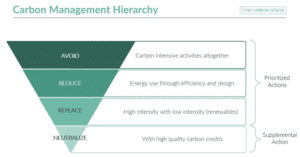Last month, the Science Based Targets initiative (SBTi) made sustainability headlines by announcing that it would consider allowing companies to use carbon credits, and other environmental attribute certificates, to achieve their Science Based Targets. While the change was welcomed by some, it prompted serious pushback from SBTi staff, partners, and environmental groups.
So, what’s all the fuss about? We’re here to break down what we know about the change, what we hope to see from it, and what you can do to prepare.
The Change
The SBTi has emerged as the leading framework for setting corporate carbon emissions reduction goals aligned with the latest climate science. As a rule of thumb, alignment requires halving Scope 1, 2, and 3 emissions by 2030 and achieving near net zero emissions by 2050 with a reduction-first approach. What changed last month?
The old: The SBTi has traditionally permitted carbon credits to be used to neutralize a maximum of 10% of total residual emissions within the target year.
The new: The new proposal, announced by the SBTi on April 9, 2024, could expand carbon credit application within Scope 3 emissions, which are often the most difficult to reduce.
Why the Change?
This announcement comes after six months of stakeholder consultation, and a January 2024 announcement that the SBTi is working to “revise its flagship Corporate Net-Zero Standard” and provide “additional guidance on tackling Scope 3 emissions”. While the exact reasoning for this change has not yet been stated, the SBTi has previously acknowledged a need for increased guidance around carbon removals in response to industry feedback and an open letter from Carbon Plan, a non-profit studying climate solutions.
While the SBTi’s sector-specific target criteria are aligned with global climate science, the feasibility of the pathway to achievement is not always as clear. More than 5,000 companies have set science-based targets through the SBTi; however, less than half report progress on all of their near and long term targets, leaving a significant gap in our understanding of how company performance compares to ambition.
Further, as our clients have embarked on achieving their ambitious 2030 goals, we have seen a rising need for investment in research, technology, and third-party reductions to enable deep emissions reductions at scale. Some emissions are well within our clients’ ability to directly influence and abate, while others are farther removed from influence and/or feasible abatement mechanisms.

What the Change Means: EACs in the Mix
While maintaining pressure on Scope 3 reporting and reductions, additional abatement measures may still be needed to fill the gap. SBTi’s latest announcement indicates that they are investigating environmental attribute certificates (EACs) as a pathway to achieving this.
What are those? Environmental attribute certificates (EACs) are instruments used to quantify, verify, and track the environmental benefits associated with climate mitigation activities or projects. From the SBTi’s perspective, this includes emissions reduction or carbon credits, Energy Attribute Certificates for renewable energy (RECs), and other energy carrier and certified commodity certificates such as those resulting from green hydrogen and sustainable aviation fuel, for example.
While EACs can play a key role in addressing the climate crisis, serious concerns have been raised regarding the reality of the environmental impacts they represent.
The SBTi is currently analyzing the results of a call for evidence regarding EACs and is planning to release a draft proposal on this topic in July. Acknowledgement of the role EACs play in corporate climate action and increased transparency around the use of EACs will bring SBTi target achievement criteria in closer alignment with other net zero frameworks, such as the World Green Building Council Net Zero Commitment, as well as expanded disclosure regulation recently passed by California and the U.S. Securities and Exchange Commission (SEC).
Our Recommended Guidance
We hope to see the following elements in the draft guidance:
-
- Clear boundaries on the use and reporting of EACs to support transparency, avoid dilution of existing and future SBT commitments, and ensure EACs are used as a complement to decarbonization pathways that maximize reductions.
- Science-based guidelines for defining high quality carbon removals with long term, verifiable reduction.
- Alignment with best practices from existing, industry-leading EAC frameworks, such as the Voluntary Carbon Markets Initiative (VCMI) and Integrity Council for the Voluntary Carbon Market (ICVCM) and planned guidance updates from the Greenhouse Gas Accounting Protocol.
How to Prepare
As of the writing of this article, there have been no formal changes to the SBTi standards and companies are recommended to maintain their current SBTi roadmap. Keep an eye out for the draft guidance this July, which is expected to include formalized pathways for feedback. Notable for real estate firms: the draft SBTi Buildings Sector Guidance is likely to be finalized this fall.
You can prepare by learning more about EACs and carbon credits by referencing our Carbon Credits FAQ series, What They Are & Why They Matter for Net Zero and How and When to Get Started, as well as our GRESB Insights article on Why Carbon Insurance: Decarbonization Meets Risk Management.
As always, we’re here to support your decarbonization journey. Reach out to discuss yours with our carbon experts.




